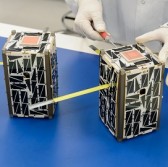 NASA sent two Nodes small satellites to the International Space Station via an Orbital ATK cargo ressuply mission on Dec.6 to explore the potential of small, low-cost satellites in future missions.
NASA sent two Nodes small satellites to the International Space Station via an Orbital ATK cargo ressuply mission on Dec.6 to explore the potential of small, low-cost satellites in future missions.
The agency said Wednesday the Nodes mission will deploy two identical 4.5 pound CubeSats into low-Earth orbit in mid-March to test their ability to receive and distribute commands from the ground as well as exchange data through their Energetic Particle Integrating Space Environment Monitor.
Roger Hunter, NASA Ames Research Center program manager for Small Spacecraft Technology Program, said the Nodes work to demonstrate inter-satellite communications and autonomous command and control that can be applied to future constellations.
NASA noted the Nodes satellites employ Android smartphone technology based on the agency’s Phonesat project but with custom software modifications to enable spacecraft functions.
Both CubeSats will be on mission for two weeks and will remain in orbit for months until they decay and burn upon re-entry into Earth’s atmosphere, NASA said.
The EPISEM instruments were built by Montana State University with ground operations facilitated by Santa Clara University under SSTP partnerships.




